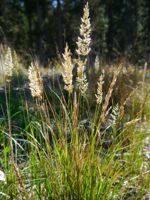Mon-Fri 9am - 5pm Mountain time
Pinegrass vs Nodding Onion
Calamagrostis rubescens
Allium cernuum
CUSTOM GROW
NOT AVAILABLE THIS SEASON - MIGHT RETURN
Pinegrass is a hardy, native perennial grass common in forested regions of western North America. It is an important understory species and is typically found beneath conifer canopies. Due to its spreading nature and ability to form dense mats that cover the forest floor, it helps stabilize soils and reduce erosion.
It provides forage for wildlife and livestock, shelter for small animals, and seeds for birds, playing an important ecological role in woodland ecosystems. Pinegrass is well-suited for ecological restoration, soil stabilization, and naturalization projects.
Nodding Onion is a native perennial wildflower known for its nodding clusters of flowers that range in color from white to pink to purple. The lightly scented blooms provide pollen and nectar for pollinators, especially bees, which can collect while hanging upside down, a capability most other insects lack.
The narrow, grass-like leaves of the Nodding Onion can be used as a seasoning in cooked dishes, though bulbs and raw leaves should not be eaten in large quantities. All parts of the plant have an onion-like aroma when bruised, which helps deter deer and rabbits. They can self-seed readily, so removing spent blooms helps manage their spread. Tolerant of a range of soils, including alkaline, it is well-suited for a variety of plantings, including pollinator gardens and naturalization projects.
Pinegrass Quick Facts
Nodding Onion Quick Facts
Toxicity: raw leaves and bulbs can be midly toxic

